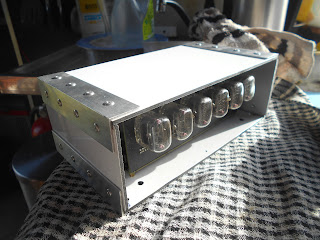Project will measure the level of water in my 300 Litre tank and the Temp Humidity in the Boltonwagen.
Sensors:
JSN-SR04T-2.0
AM2302 DHT22 Temperature And Humidity Sensor Module For Arduino SCM
Specification:
Electrical properties:
Operating voltage: DC 5V
Total current work: 40mA
Acoustic emission frequency: 40khz
Farthest distance: 4.5m
Blind: 25cm
Resolution: about 0.5cm
Angle: 70 degrees
Working temperature: -10 ~ 70 ℃
Storage temperature: -20 ~ 80 ℃
Wiring:
+ 5V (positive power supply) RD
Trig (control side) RX D 11 WH
Echo (the receiver) TX D 12 GY
GND (negative) BLK
Principle of Operation:
(1) using IO port TRIG trigger location, to the high level signal of at least 10us;
(2) module automatically sends 8 40KHz pulse, automatic detecting whether a signal return;
(3) a signal return, a high level is output through the IO port ECHO, the time duration of the high level is
ultrasonic from launch to return. The test distance = (high level time * speed of sound (340M/S)) /2;
Software & Refs :
Library for Ultrasonic Sensor
https://github.com/daPhoosa/MedianFilter
https://www.youtube.com/watch?v=wb0sTy_26XM&ytbChannel=null
http://www.ardumotive.com/how-to-use-dht-22-sensor-en.html#
https://www.banggood.com/DC-5V-Waterproof-Ultrasonic-Module-Distance-Measuring-Transducer-Sensor-p-1094462.html
Tank Dimensions:
W 2109 x D 185 x H 770 (Measured Dimension) 300 Litres
____________________________________________________________
/* How to use the DHT-22 sensor with Arduino uno
---------------------------------------------------------------------------
Project will measure the level of water in my 300 Litre tank and Temperature and humidity.
---------------------------------------------------------------------------
More info: http://www.ardumotive.com/how-to-use-dht-22-sensor-en.html
Dev: Michalis Vasilakis // Date: 1/7/2015 // www.ardumotive.com
Mark Bolton
7 September 2018
Two sketches are combined. //water and //temp
*/
//Libraries
#include <dht.h> //temp
#include <NewPing.h> //water
#include <MedianFilter.h>
#include <Wire.h>
#define TRIGGER_PIN 12 // Arduino pin tied to trigger pin on the ultrasonic sensor.
#define ECHO_PIN 11 // Arduino pin tied to echo pin on the ultrasonic sensor.
#define MAX_DISTANCE 800 // Maximum distance we want to ping for (in centimeters). Maximum sensor distance is rated at 400-500cm.
dht DHT;
//Constants
#define DHT22_PIN 8 // DHT 22 (AM2302) - what pin we're connected to
//Variables
float hum; //Stores humidity value
float temp; //Stores temperature value
int tank_Depth = 18; // Tank Depth (cm)
int tank_Width = 211; // Tank Width (cm)
//int US_ROUNDTRIP_CM; // Tank Height (cm) from sensor.
int water_Volume; // Amount of water in the tank. (Litres)
NewPing sonar(TRIGGER_PIN, ECHO_PIN, MAX_DISTANCE); // NewPing setup of pins and maximum distance.
MedianFilter filter(31,0);
void setup()
{
Serial.begin(9600);
}
void loop()
{
int chk = DHT.read22(DHT22_PIN);
//Read data and store it to variables hum and temp
hum = DHT.humidity;
temp= DHT.temperature;
delay(100); // Wait 50ms between pings (about 20 pings/sec). 29ms should be the shortest delay between pings.
unsigned int o,uS = sonar.ping(); // Send ping, get ping time in microseconds (uS).
filter.in(uS);
o = filter.out();
//Print temp and humidity values to serial monitor
Serial.print("Hum: ");
Serial.print(hum);
Serial.print(" %, Temp: ");
Serial.print(temp);
Serial.print(" C. ");
//Print level and Volume to monitor
Serial.print("Level: ");
Serial.print( o / US_ROUNDTRIP_CM);
/* Convert ping time to distance in cm and print result (0 = outside set distance range)*/
Serial.print("cm.");
/* calculate volume .001 to convert to Litres / cm. * D * W * H (77) - distance from surface of the water to the sensor. */
water_Volume = 0.001 * tank_Depth * tank_Width * 77 - o / US_ROUNDTRIP_CM;
Serial.print(" Vol: ");
Serial.print(water_Volume);
Serial.print(" L");
// CSV file
Serial.print(" ");
Serial.print(hum);
Serial.print(",");
Serial.print(temp);
Serial.print(",");
Serial.print( o / US_ROUNDTRIP_CM);
Serial.print(",");
Serial.println(water_Volume);
}
Problem. dht.h not a valid library. I removed all DHT Libraries and reinstalled the zip file included in the tutorial.
I
built a replica Prototype Unit to clean up the code and get some more
sensors and setup a proper Python controller in the Pi but none of the
Sketches would verify. I cant identify the issue but clearly it is a
problem with the Libraries. The best approach under these circumstances
is to go back to scratch and set up the system again.
Fixed. Just gradually rebuilt the other few libraries and now the Water Level Sketch works too.
BUT : Pulled the unit to bits (for unrelated reasons) and will revisit later...
Might want to double check the formula on the Height to Volume calculation.
The Heater Fuel Sender needs monitoring as well.
















